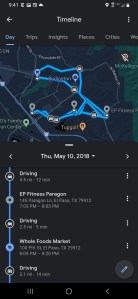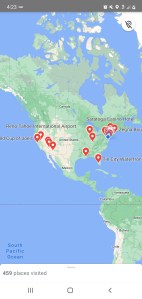Google can and does track users’ movements and stores the information for years. The tracking includes where users go, how many miles they drive, the length of time it takes to get there, and how long they spend at the destination.

This screenshot of Google timeline shows a map of the exact routes driven, and the exact time spent at destinations including the address from May 2018.
Many people are familiar with Google’s “location reporting” and “location history.” The technology allows Google Maps to find the best routes to drive for avoiding traffic, busy areas in cities and local businesses like restaurants for people looking for a bite to eat. Millions of people use the features to make their lives more convenient. But Google users Straight Arrow News spoke with were not familiar with the level of detail of the tracking, or how long Google stores that information.
“Oh my gosh, this is going back nine years,” Samsung user Conner Schobel said when he realized Google still has his data from nearly a decade ago. Schobel noted he has only owned his current phone for 18 months.
The timeline has meticulous detail. There is a national map showing the cities he has visited, in addition to a list of all the restaurants, stores, gyms, hotels and airports. Google also has personal and potentially protected information, like two visits to a doctor’s office six years ago. The company announced it will begin deleting sensitive or private information soon after it is collected.
“I honestly see this as, maybe even a breach of my sovereignty. This is a little bit too far,” Schobel said. “I value my privacy. I don’t see why a large technology corporation should be tracking, keeping and storing all the data of where I’ve been.”
A spokesperson for Google said the information is never shared with third parties and that permission was given for all information gathered when turning on “location history”, which is an optional feature and turned off by default.
“If you choose to turn Location History on, you’ll see your Timeline, a tool that helps you reminisce and remember places you’ve visited. To keep you up to date, we send frequent reminders that Location History is enabled, and provide simple controls so you can manage your data easily,” a Google spokesperson told Straight Arrow News.

A map revealing all the places Schobel has travelled around the country. He did not know this data had been stored.
Alexis Hancock, director of engineering for the Electronic Frontier Foundation has questions. “On the other hand, the reason why they do it may be profit motive. Because they are the biggest ad revenue tracking based company there is,” she said. “Does this company know a little too much about you when their biggest source of revenue is ads?”
Google provides specific instructions on how to delete location history. The settings can also be adjusted to automatically delete data after three, 18, or 36 months. They also provide monthly reminders to users who have it active so they can adjust the settings.
Hancock argued it should be easier for users to know when location history is in use. Users reviewed data that was collected when they weren’t actively using their phone, but had it with them.
“That’s a huge assumption that they’re making for you. And that’s the big problem there, when they’re using web and app activity or when you have location services turned on and may not realize it,” Hancock said.
Google provides information for people who want to know about location services in their Help Center, blog, and policy page.








